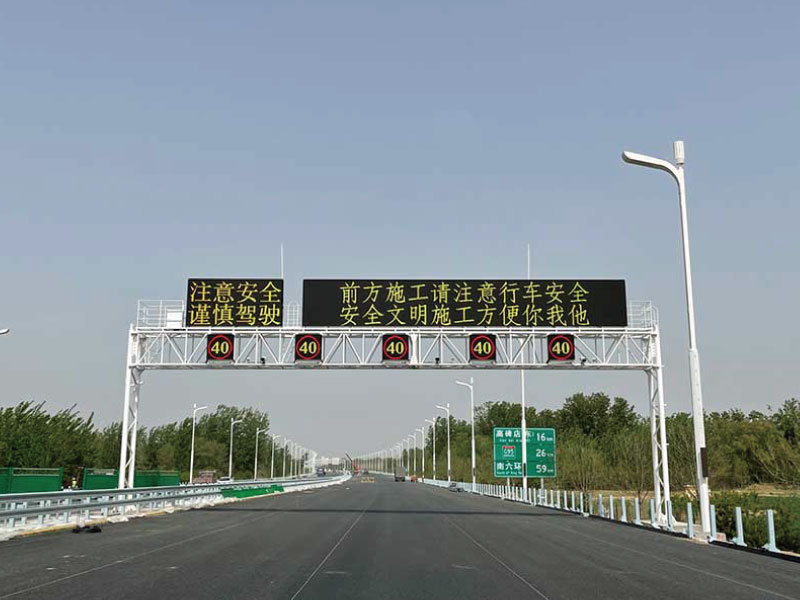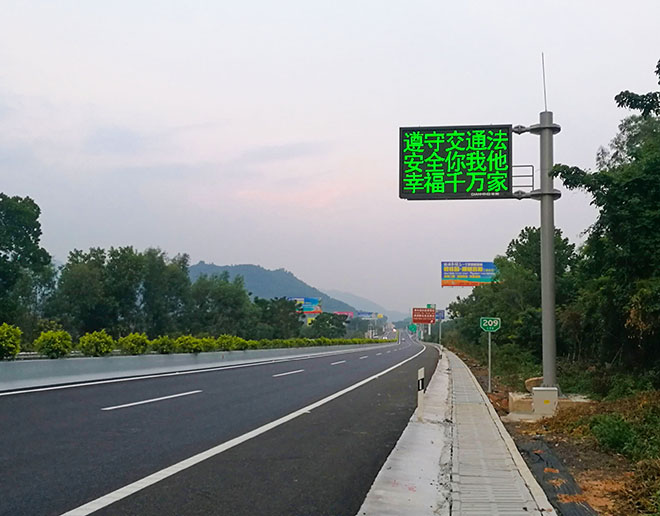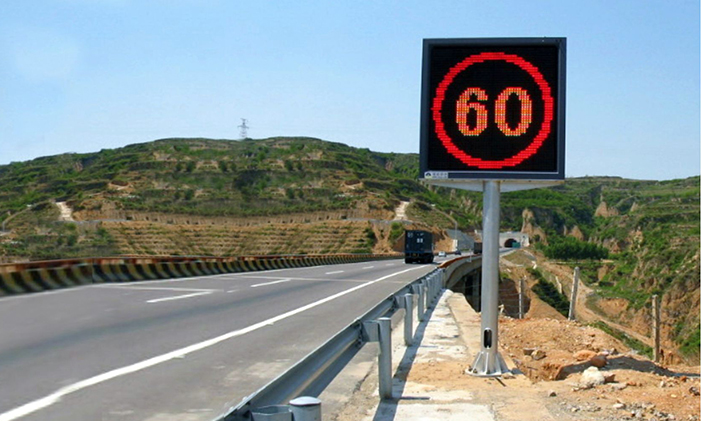Variable Message Sign
Variable Message Signs
Variable Message Signs (VMS) are key elements of dynamic traffic management systems. Our variable message signs are often used on roadways to give travelers and motorists information, warning and guidance on the traffic situation. These LED road traffic signs warn of traffic congestion, accidents, incidents, roadwork zones, or speed limits on a specific highway segment. Traffic Network VMS are specifically designed to cater to your environment and traffic condition – durable and high power efficiency.
For more information on our road safety products, please contact us!
LED display price
Just fill the sizes, and get your led screen budget right now !
Variable message signs for roadways
Variable Message Signs (VMS) are advanced electronic display panels designed for road traffic management, combining text and graphic messages to enhance traffic control effectively.
Smart variable messaging signs
In the whole intelligent transportation equipment, HARSE specially developed LED information board is an important component of the intelligent high-speed, which has gradually evolved into a terminal of the intelligent Internet of things, known in the industry as the “LED intelligent Internet of things screen”.
It fully combines the big data, mobile internet and other technologies, integrates the traffic guidance, media display, emergency display, data presentation, information feedback and other functions.
Variable message signs really becomes the most intuitive display terminal in the intelligent high-speed system.


Variable message signs traffic
Variable speed limit sign display screen, referred to as speed limit screen, is a kind of traffic guidance products used to release traffic speed limit information, which is widely used in highways, urban important traffic arteries and other places. By customizing the speed limit value, the speed limit screen can timely and flexibly show the driver driving speed tips to ensure driving safety.

Lane Indicator Sign
Lane indicator is usually installed at the entrance of each lane of highway toll station, used to indicate the passage status of the lane, is an important guarantee of highway safety. Sansi lane indicator has high brightness, strong penetration ability, the content of the prompt in the longer distance or foggy weather can still be clearly visible, play a good role in warning; good reliability, high level of protection, bad weather can still work normally.
Variable information boards for highways
variable message sign boards is a widely used in highway display products, with high brightness, strong penetration ability, good reliability, high protection level, and its prompt content can still be clearly visible at a distance or foggy weather, to ensure the safe passage of high speed.


F-type variable message sign board
F-type information board is a widely used in highway display products, with high brightness, strong penetration ability, good reliability, high protection level, and its prompt content can still be clearly visible from a distance or foggy weather, to ensure the safe passage of high speed.

T-type variable message sign board
T-type information board is a widely used in highway display products, with high brightness, strong penetration ability, good reliability, high protection level, and its prompt content can still be clearly visible in the longer distance or foggy weather, to ensure the safe passage of high speed.
GET QUOTE NOW
Variable Message Signs: A Key Component in Smart Transportation Systems
Variable Message Signs (VMS) are electronic displays used to convey information to drivers in real-time. These signs play a crucial role in enhancing communication between transportation agencies and road users. By providing timely updates on traffic conditions, road closures, weather alerts, and other essential information, VMS significantly contribute to the overall efficiency of transportation networks.
Click Here to Jump!
- Introduction to Variable Message Sign (VMS)
- The Evolution of VMS in Transportation Systems
- Key Functions of Variable Message Sign
- Types of Variable Message Sign
- VMS Integration in Smart Transportation Networks
- Benefits of VMS for Traffic Management
- Enhancing Road Safety with Variable Message Signs
- VMS Technology: Hardware and Software Components
- Implementation Challenges and Solutions
- Future Trends: AI and IoT in VMS Systems
- Regulatory Aspects and Standards for VMS Usage
- Conclusion: The Role of VMS in Shaping Future Smart Cities
1.Introduction to Variable Message Sign (VMS)
In today’s fast-paced world, the importance of clear and immediate communication cannot be overstated. With increasing traffic congestion and the need for efficient navigation, VMS have emerged as a vital tool for managing roadway systems effectively. They help mitigate traffic issues by guiding drivers and providing crucial information that influences their travel decisions.
Furthermore, VMS are not just static signs; they are integrated components of smart transportation systems that leverage technology to improve road safety and traffic management. Their adaptability and real-time capabilities make them a preferred choice for modern cities looking to enhance their transportation infrastructure.
2.The Evolution of VMS in Transportation Systems
The development of Variable Message Signs has a rich history rooted in the need for better traffic management. Initially, VMS were simple static signs that displayed basic information. As technology advanced, so did the functionality of these signs. The introduction of electronic displays allowed for dynamic messaging, enabling transportation authorities to relay real-time information.
Over the years, the evolution of VMS has been influenced by various factors, including advancements in technology, the increasing volume of road traffic, and the growing demand for safer transportation systems. The integration of digital technology has transformed VMS from traditional road signs into sophisticated systems that can be updated remotely and programmed to display a wide range of messages.
Today, VMS are equipped with cutting-edge features, such as integration with traffic management systems, sensors, and even artificial intelligence. This evolution reflects a broader trend in transportation where data-driven decision-making is becoming the norm, ultimately leading to smarter and more responsive travel environments.
3.Key Functions of Variable Message Sign
Variable Message Sign serve several key functions that significantly enhance road safety and traffic management. Here are some of the primary roles that VMS fulfill:
Traffic Information Dissemination: VMS provide real-time updates on traffic conditions, including congestion levels, accidents, and road closures. This information enables drivers to make informed decisions about their routes.
Safety Alerts: These signs can display critical safety information, such as speed limits, hazardous weather conditions, and warnings about roadwork or accidents ahead. This immediate communication can help prevent accidents and improve overall safety on the roads.
Travel Time Estimates: VMS can display estimated travel times for various routes, allowing drivers to choose the most efficient path to their destinations. This function is particularly useful during peak travel times or in areas prone to delays.
By fulfilling these roles, Variable Message Signs play an essential part in the functioning of modern transportation systems, ensuring that drivers have access to the information they need to navigate safely and efficiently.
4.Types of Variable Message Sign
Variable Message Sign come in various types, each designed to serve specific purposes within the transportation network. Understanding these types can help you appreciate how VMS are implemented in different contexts:
Static VMS: These are fixed signs that display pre-programmed messages. While they are less flexible than dynamic signs, they are still useful for conveying consistent information, such as speed limits or directional guidance.
Dynamic VMS: These signs can change their messages in real-time based on traffic conditions. They are often used for displaying alerts, travel times, or other variable information.
Matrix Signs: Utilizing LED technology, matrix signs can display text, symbols, and even graphics. Their versatility makes them ideal for conveying complex information quickly and effectively.
Lane Control Signs: These specialized VMS are used to manage lane availability, indicating whether lanes are open or closed to traffic. They are commonly seen on highways and in tunnels.
By utilizing different types of Variable Message Signs, transportation agencies can deliver tailored messaging to drivers, enhancing their navigation experience and promoting safety on the roads.
5.VMS Integration in Smart Transportation Networks
The integration of Variable Message Signs into smart transportation networks marks a significant advancement in traffic management. Smart transportation systems leverage technology and data analytics to create more efficient and responsive environments. VMS play a pivotal role in this integration by serving as a communication link between road users and transportation authorities.
Data Communication: Smart transportation systems rely on real-time data from various sources, including traffic sensors and GPS devices. VMS can display this information to drivers, helping them adapt their routes based on current conditions.
Centralized Control: Through centralized management systems, transportation agencies can control VMS across a network. This allows for coordinated messaging during emergencies or significant events, ensuring that all drivers receive consistent and timely information.
User-Centric Approach: By integrating VMS into smart transportation systems, agencies can focus on the needs of road users. This user-centric approach enhances the overall travel experience, making it safer and more efficient.
Incorporating VMS into smart transportation networks not only improves traffic management but also supports the development of sustainable transportation solutions that benefit everyone.
6. Benefits of VMS for Traffic Management
The implementation of Variable Message Sign provides numerous advantages for traffic management. Here are some key benefits that VMS bring to transportation systems:
Improved Traffic Flow: By providing real-time information, VMS help reduce congestion and increase the overall efficiency of road networks. Drivers can make informed decisions that minimize delays and improve traffic flow.
Enhanced Decision-Making: When drivers receive timely updates about road conditions, they are better equipped to make choices that affect their travel. This leads to reduced frustration and a more pleasant driving experience.
Accident Prevention: By alerting drivers to hazards and changes in road conditions, VMS can play a crucial role in preventing accidents. The immediate dissemination of safety information can significantly reduce the likelihood of collisions.
Through these benefits, Variable Message Sign contribute to creating safer and more efficient transportation systems that meet the needs of modern road users.
7.Enhancing Road Safety with Variable Message Signs
Safety is a paramount concern for any transportation system, and Variable Message Signs are instrumental in enhancing road safety. By effectively communicating critical information, VMS can significantly reduce the risk of accidents and improve overall roadway safety.
Warning Signals: VMS can display warnings about dangerous conditions, such as icy roads, fog, or construction zones. By alerting drivers to potential hazards ahead, VMS provide them with the opportunity to adjust their driving behavior accordingly.
Speed Management: Signs that display current speed limits or alert drivers to their current speed can help encourage compliance with traffic regulations. This proactive approach to speed management can lead to fewer speeding-related incidents.
Emergency Notifications: In the event of an emergency, VMS can serve as essential communication tools. They can relay instructions or warnings to drivers, helping to facilitate safe evacuations or diverting traffic away from hazardous areas.
By enhancing road safety through effective communication, Variable Message Signs play a vital role in creating safer driving environments.
8.VMS Technology: Hardware and Software Components
The effective operation of Variable Message Signs is dependent on a combination of hardware and software components. Understanding these elements can provide insight into how VMS function within transportation networks.
Hardware Components
Display Panels: These are the primary components of VMS, typically made up of LED or LCD technology. They are designed to be highly visible in various weather conditions and lighting situations.
Control Systems: VMS are equipped with control systems that allow for the programming and updating of messages. These systems can be centralized or localized, depending on the network’s design.
Sensors: Many modern VMS are integrated with traffic sensors that gather data about vehicle flow, speed, and density. This information can inform the messages displayed on the signs.
Software Components
Message Management Software: This software enables transportation agencies to create, schedule, and manage the messages displayed on VMS. It often includes features for real-time updates based on traffic conditions.
Data Analytics Tools: By analyzing data from sensors and other sources, transportation agencies can optimize VMS messaging strategies, ensuring that drivers receive the most relevant information.
Integration Platforms: These platforms facilitate the integration of VMS with other smart transportation technologies, allowing for coordinated messaging and improved traffic management.
Together, these hardware and software components enable Variable Message Signs to function effectively as part of modern transportation systems.
9. Implementation Challenges and Solutions
While Variable Message Signs offer significant benefits, their implementation is not without challenges. Addressing these challenges is crucial for maximizing the effectiveness of VMS within transportation networks.
Common Challenges
Cost: The initial investment required for VMS installation can be substantial. Budget constraints may limit the ability of transportation agencies to deploy these systems widely.
Maintenance: Regular maintenance is essential to ensure that VMS remain operational and display accurate information. Agencies may struggle with the ongoing costs and logistics of maintaining these signs.
Public Acceptance: Drivers may need time to adjust to the presence of VMS and understand their significance. Effective communication and education are necessary to promote acceptance and proper use of these signs.
Potential Solutions
Funding Opportunities: Transportation agencies can explore federal, state, and local funding opportunities to offset the costs associated with VMS implementation. Grants and public-private partnerships can also provide financial support.
Routine Maintenance Plans: Developing comprehensive maintenance plans can help ensure that VMS are regularly checked and serviced, reducing downtime and enhancing reliability.
Public Awareness Campaigns: Educating the public about the benefits and functions of VMS can foster acceptance and encourage drivers to utilize the information provided.
By proactively addressing these challenges, transportation agencies can successfully implement Variable Message Signs and enhance the effectiveness of their transportation systems.
10. Future Trends: AI and IoT in VMS Systems
As technology continues to evolve, the future of Variable Message Signs looks promising, particularly with the integration of artificial intelligence (AI) and the Internet of Things (IoT). These advancements are set to revolutionize how VMS operate and interact with transportation networks.
Smart Data Analytics: AI can analyze vast amounts of data from various sources, enabling VMS to deliver highly relevant and timely messages. This predictive capability can significantly enhance traffic management efforts.
IoT Connectivity: By connecting VMS to IoT devices, transportation agencies can gather real-time data from vehicles, pedestrians, and other infrastructure elements. This connectivity can facilitate more dynamic and responsive messaging.
Autonomous Vehicle Integration: As autonomous vehicles become more prevalent, VMS will play a crucial role in communicating with these vehicles. Dynamic messaging tailored to autonomous systems can enhance safety and efficiency on the roads.
With AI and IoT integration, the future of Variable Message Signs promises improved functionality and responsiveness, contributing to the development of smarter transportation networks.
11.Regulatory Aspects and Standards for VMS Usage
The deployment and operation of Variable Message Signs are subject to various regulatory aspects and standards. These guidelines ensure that VMS are used effectively and safely within transportation networks.
National and Local Regulations: Different regions may have specific regulations governing the use of VMS. Transportation agencies must adhere to these regulations to ensure compliance and safety.
Standardization of Messaging: Establishing standardized messaging protocols can enhance the effectiveness of VMS. Consistency in the information displayed helps drivers understand and respond appropriately to the messages.
Safety Guidelines: Regulatory agencies often provide safety guidelines for the placement and operation of VMS. These guidelines consider factors such as visibility, location, and potential distractions for drivers.
By following regulatory aspects and standards, transportation agencies can maximize the effectiveness of Variable Message Signs while ensuring safety and compliance.
12.Conclusion: The Role of VMS in Shaping Future Smart Cities
Variable Message Signs are more than just road signs; they are vital components of smart transportation systems that enhance traffic management, improve safety, and support the development of sustainable urban environments. As cities continue to evolve, the role of VMS will become increasingly significant in shaping the future of smart cities.
By embracing advancements in technology, including AI and IoT integration, transportation agencies can optimize the functionality of VMS and create more efficient systems. The benefits of VMS extend beyond traffic management; they contribute to safer roads, improved travel experiences, and reduced environmental impact.
As urban areas grow and traffic demands increase, investing in Variable Message Signs and smart transportation systems will be essential for creating livable, efficient, and sustainable cities. By prioritizing communication and real-time information, transportation agencies can ensure that road users navigate safely and efficiently.
Call to Action: If you are interested in learning more about how Variable Message Signs can enhance traffic management and improve road safety in your community, feel free to reach out for more information or consult with transportation experts. Your input can help shape the future of smart transportation systems!
Send Us A Message
To learn more about how conference LED display can transform your business, schedule a consultation with one of our audiovisual experts today!



